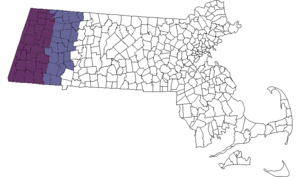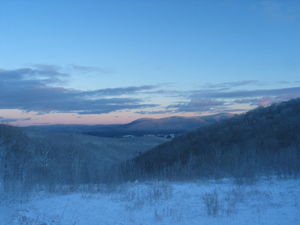Berkshires

The Berkshires (pronounced as Template:IPA or Template:IPA) is a region located in Western Massachusetts (with portions located in the adjacent states of Vermont, New York, and Connecticut). The region is also often referred to as the "Berkshire Hills" and Sir Francis Bernard, the Royal Governor, named the area "Berkshire," to honor of his home county in England. Tourism is a principal industry, relying heavily on cultural art attractions and recreation. Mount Greylock, 3,491 ft (1,064 m), is the highest point in the Berkshire region and in the state, but average regional elevation ranges from about 700 to 1,200 feet (213 to 365 meters). The Housatonic, Hoosic, and Westfield River watersheds primarily drain from the region. Pittsfield, North Adams, Adams, Great Barrington, and Williamstown are the largest municipalities in the Berkshires.
Context
Depending on the application, "The Berkshires" may have several different meanings. Geographically, the Berkshire Hills are a southern extension of the Green Mountains, but it is also generally applied to all highlands in Western Massachusetts. Politically, Berkshire County was a governing body formed in 1761 and mostly discontinued in 2000. Culturally, the Berkshire region is the extreme western region of Massachusetts including adjacent portions of southern Vermont, eastern New York and northwestern Connecticut that is associated with tourism and the arts. [1][2]
Geology
Over half a billion years ago Africa collided with North America, pushing up the Appalachian Mountains and forming the Taconic bedrock of the Berkshires. Erosion over hundreds of millions of years wore these mountains down to the hills that we see today. See also: Taconic orogeny.
Ecology
As a framework for assessing environmental resources, the United States Environmental Protection Agency in Massachusetts (Griffith et al. 1994) has defined six different types of "ecoregions" within this area: Taconic Mountains, Western New England Marble Valleys, Lower Berkshire Hills, Berkshire Highlands, Vermont Piedmont, and Berkshire Transition. Within each of the ecoregions topography, geology, soils and plant and animal habitats are relatively homogeneous. However each region is distinct from the others providing a unique habitat assemblage. Much of the Hoosic and Housatonic River Valleys have underlying bedrock limestone and marble which contribute to calcareous wetlands, unique to Massachusetts. The alkaline pH waters support a diversity of plants and animals intolerant of more acidic waters, some which are state-listed rare or endangered. Combined with the rich mesic forests ranging from the northern hardwood to the taiga or sub-alpine, makes for a valuable, biologically diverse ecosystem.
The classic study of the vegetation of the Berkshire Highlands was Egler's 1940 monograph,[1] covering the flora of an area stretching roughly from Pittsfield, MA in the west to Hatfield, MA in the east, and from Goshen, CT in the south, north to the Vermont border.
Today, efforts are being made on behalf of many organizations to preserve and manage this region for biological diversity and sustainable human development. Recreation directly related to this ecology is a popular area for trout fishing, and the area's relative pristineness contributes to the popularity of nature walks in the region. See also: Natural History of the Berkshires
Sightseeing
The Berkshires are a popular tourist attraction and vacation getaway, serving the same function in relation to Connecticut and Massachusetts that the Catskills do in New York and the Poconos for Pennsylvania. With numerous trails, including part of the Appalachian Trail, large tracts of wilderness, parks like Kent Falls, Berkshire Botanical Garden and Hebert Arboretum the Berkshires are very popular with nature lovers. The range includes Bash Bish Falls, the tallest waterfall in Massachusetts.
Northwestern Connecticut features the covered bridges of Kent and West Cornwall, fly fishing, canoeing and spectacular fall foliage along the Housatonic River valley and the quiet woods and lichen-covered cracked granite hills of the Appalachian trail.
Tanglewood Music Center in Lenox is the summer home of the Boston Symphony Orchestra. The Chapin Library at Williams College displays a wide selection of rare books and documents. The Norman Rockwell Museum, Clark Art Institute, Massachusetts Museum of Contemporary Art (MassMoCA), and Williams College Museum of Art (WCMA) comprise the region's diverse selection of art museums, and Gallery 51, Carrie Haddad Gallery and Kolok Gallery are three of the Area's highly regarded private art galleries.
The area is also home to numerous summer stock theatre festivals, such as the Williamstown Theatre Festival (Williamstown), Berkshire Theatre Festival (Stockbridge), Shakespeare and Company (Lenox), and plays host to America's first and longest-running dance festival, Jacob's Pillow. The Berkshires are also home to dozens of summer camps, some of which date back to the turn of the 20th Century, the oldest being Becket Chimney Corners YMCA. Also, one of the most impressive camps being the all-boys camp Camp Greylock [3].
See also
- BerkShares
- Massachusetts geography
- Vegetation of New England
- Famous Berkshire Cottages: Naumkeag, Edith Wharton's The Mount, Ventfort Hall and Arundel Hall, used in the book The Penderwicks
External links
- Browse the Berkshires
- Berkshire Visitor's Bureau
- Berkshire Visual Arts Guide to Galleries, Museums and Art Organizations
- Berkshire Chamber of Commerce
- Massachusetts State Parks in the Berkshires
- Explore the Berkshire Foothills of Western Massachusetts
- ↑ Egler, F. E. 1940. Berkshire plateau vegetation, Massachusetts. Ecological Monographs 10:147-192.
